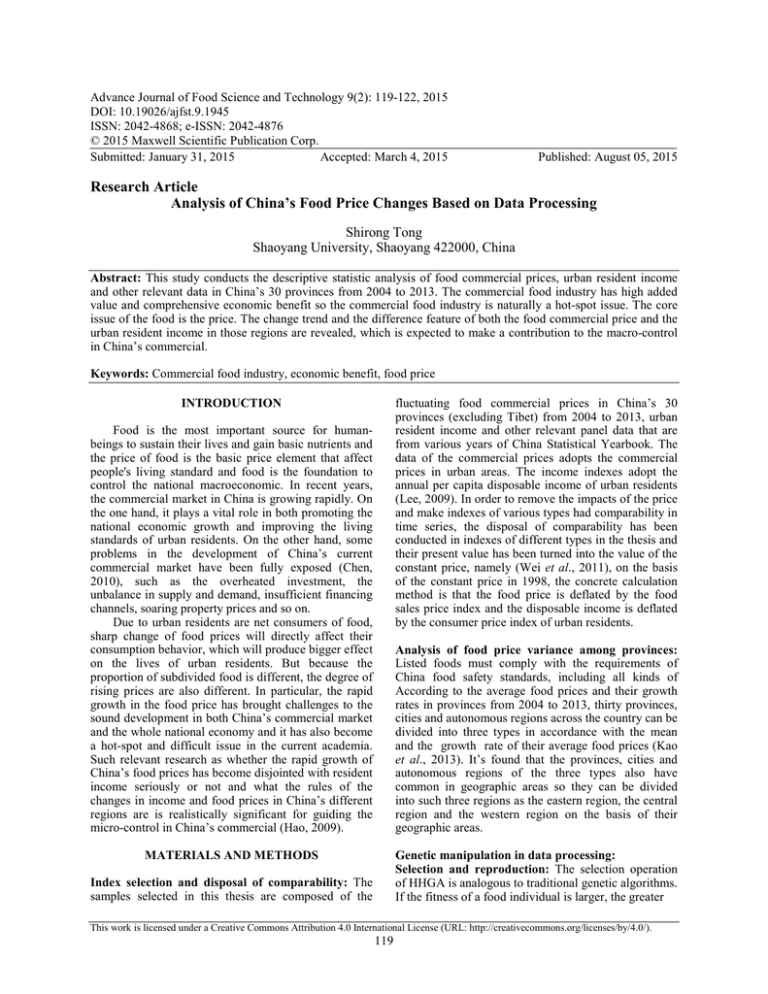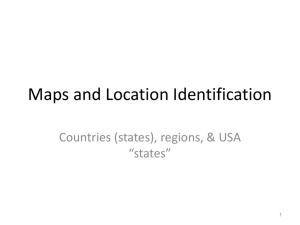Advance Journal of Food Science and Technology 9(2): 119-122, 2015
advertisement

Advance Journal of Food Science and Technology 9(2): 119-122, 2015 DOI: 10.19026/ajfst.9.1945 ISSN: 2042-4868; e-ISSN: 2042-4876 © 2015 Maxwell Scientific Publication Corp. Submitted: January 31, 2015 Accepted: March 4, 2015 Published: August 05, 2015 Research Article Analysis of China’s Food Price Changes Based on Data Processing Shirong Tong Shaoyang University, Shaoyang 422000, China Abstract: This study conducts the descriptive statistic analysis of food commercial prices, urban resident income and other relevant data in China’s 30 provinces from 2004 to 2013. The commercial food industry has high added value and comprehensive economic benefit so the commercial food industry is naturally a hot-spot issue. The core issue of the food is the price. The change trend and the difference feature of both the food commercial price and the urban resident income in those regions are revealed, which is expected to make a contribution to the macro-control in China’s commercial. Keywords: Commercial food industry, economic benefit, food price fluctuating food commercial prices in China’s 30 provinces (excluding Tibet) from 2004 to 2013, urban resident income and other relevant panel data that are from various years of China Statistical Yearbook. The data of the commercial prices adopts the commercial prices in urban areas. The income indexes adopt the annual per capita disposable income of urban residents (Lee, 2009). In order to remove the impacts of the price and make indexes of various types had comparability in time series, the disposal of comparability has been conducted in indexes of different types in the thesis and their present value has been turned into the value of the constant price, namely (Wei et al., 2011), on the basis of the constant price in 1998, the concrete calculation method is that the food price is deflated by the food sales price index and the disposable income is deflated by the consumer price index of urban residents. INTRODUCTION Food is the most important source for humanbeings to sustain their lives and gain basic nutrients and the price of food is the basic price element that affect people's living standard and food is the foundation to control the national macroeconomic. In recent years, the commercial market in China is growing rapidly. On the one hand, it plays a vital role in both promoting the national economic growth and improving the living standards of urban residents. On the other hand, some problems in the development of China’s current commercial market have been fully exposed (Chen, 2010), such as the overheated investment, the unbalance in supply and demand, insufficient financing channels, soaring property prices and so on. Due to urban residents are net consumers of food, sharp change of food prices will directly affect their consumption behavior, which will produce bigger effect on the lives of urban residents. But because the proportion of subdivided food is different, the degree of rising prices are also different. In particular, the rapid growth in the food price has brought challenges to the sound development in both China’s commercial market and the whole national economy and it has also become a hot-spot and difficult issue in the current academia. Such relevant research as whether the rapid growth of China’s food prices has become disjointed with resident income seriously or not and what the rules of the changes in income and food prices in China’s different regions are is realistically significant for guiding the micro-control in China’s commercial (Hao, 2009). Analysis of food price variance among provinces: Listed foods must comply with the requirements of China food safety standards, including all kinds of According to the average food prices and their growth rates in provinces from 2004 to 2013, thirty provinces, cities and autonomous regions across the country can be divided into three types in accordance with the mean and the growth rate of their average food prices (Kao et al., 2013). It’s found that the provinces, cities and autonomous regions of the three types also have common in geographic areas so they can be divided into such three regions as the eastern region, the central region and the western region on the basis of their geographic areas. MATERIALS AND METHODS Genetic manipulation in data processing: Selection and reproduction: The selection operation of HHGA is analogous to traditional genetic algorithms. If the fitness of a food individual is larger, the greater Index selection and disposal of comparability: The samples selected in this thesis are composed of the This work is licensed under a Creative Commons Attribution 4.0 International License (URL: http://creativecommons.org/licenses/by/4.0/). 119 Adv. J. Food Sci. Technol., 9(2): 119-122, 2015 Table 1: The MAPE values of three models Experiment HHGA-RBFNN GA-BPNN 1 0.0076 0.0093 2 0.0077 0.0086 3 0.0080 0.0097 RBF 0.0120 0.0120 0.0120 Table 2: The RMSE values of three models Experiment HHGA-RBFNN GA-BPNN 1 20.2072 26.1209 2 20.9874 24.0441 3 21.7370 25.5099 RBF 29.5758 29.5758 29.5758 output layer can study the final optimized RBF neural network. Relationship between the regional income and the food price: This experimental data are the Food price Index closing price of 125 trading days, from July 1, 2013 to December 31, 2013, collected on the Shanghai Food Exchange. The first 107 data is taken as training sample and the remaining 18 data is presented as the testing sample from the 155th day to 185th day. In order to avoid a great range of data having a negative impact on the RBF neural network training, a food closing price xi is normalized to interval (0, 1) by: probability of selected. This food individual selection is used for the expectation value method. The expected value of the food individual determines whether food individuals of population could be divided into the next generation to optimize, the probability of food individual j is copied directly proportional to fj, the number of food individuals being copied is the value of food individual expectation vj. The expected value of the food individual used as the following formula: vj = fj f avg = fj xi = (3) where, xi is the input of neural network, max (x) and min (x) are the maximum and minimum value of the sample data, respectively. Through the normalization of xi, then imputing the sample data are regarded as the training sample of the neural network. After the network training and simulation of the sample, conducting anti-normalization process to revert the real closing price when outputting predicted results: (1) f sum / N where, fj is the food individual fitness, favg is the average fitness. fsum is the total fitness of the population, N is the size of the population. After selection and reproduction operation, the initiated population P1 becomes P2. Y ( xi ) = u ( xi ) * ( max ( x ) − min ( x ) ) + min ( x ) Crossover and mutation: The mutation operation is primarily used to maintain the diversity of population. Based on the population fitness, the population P2 is conducted crossover and mutation operations. Crossover operation creates new gene combination to form group P3. The crossover of control genes and parameter genes use single-point crossover. Due to the different encoding between control genes and parameter genes of each chromosome, the mutation of parameter genes selects real-value mutation. The mutation of control genes uses simulated binary mutation selecting randomly two food individuals x1 and x2 from the parent population, then by linear combinations to produce new offspring: y1 = ax 2 + (1 − a ) x1 y 2 = ax1 + (1 − a ) x 2 xi − min ( x ) max ( x ) − min ( x ) (4) where, u (xi) is the output of neural network. The Mean Absolute Percentage Error (MAPE) and Root Mean Square Error (RMSE) are taken as the standard to assess the predictions accuracy of the model: M APE = RM SE = 1 N 1 N N y i, − y i i =1 yi ∑ N y i, − y i i =1 yi ∑ (5) (6) where, yi' = The predicted value yi = The actual value N = The number of samples (2) where, a is a random number, a ∈ (0, 1). When the value of MAPE and RMSE is smaller, the higher forecasting accuracy of the model is possible. To avoid the influence of random factors on the experimental results, three methods are conducted three times. The results in the Table 1 and 2 show that for the experiment of predicting the closing price of SCI, the values of MPAE and RMSE of RBF network optimized by HHGA are minimized, so the predicted accuracy is maximized. Calculate weights of the network output: In the design of RBF neural network optimized by HHGA, the parameter information of output layer neurons in genetic algorithm encoding is redundant. If adding redundant information in the encoding, the efficiency of genetic algorithm will be reduced. Therefore, using HGA to determine the center Ci and width σi of radial basis function in the hidden layer, taking advantage of the least squares method to calculate the weights of 120 Adv. J. Food Sci. Technol., 9(2): 119-122, 2015 RESULTS AND DISCUSSION 3000 Analysis of the differences in the income change among regions: For the regional division of the average food price in China, Fig. 1 compares the changes in the average food prices in the central, western and eastern regions from 2004 to 2013. It’s found that the average food price in the east is prominently higher than those in the western and central regions and the trend of its average food prices is on the rise. In particular, the rising trend of the average food prices is obvious after 2004. The changes in the average food prices in eastern and western regions are comparatively similar. However, the average prices in the central region are rising slowly while for the western region, a small decline also appears in its slightly rising process. Besides, the average food prices in the eastern region surpass those in the western region after 2004. For the regional division of the average food price in China, Fig. 2 compares the changes in the income in the central, western and eastern regions from 2004 to 2013. It’s found that the per capita income in the east is prominently higher than those in the western and central regions and its trend is uniformly on the rise. According to the analysis of Fig. 1 and 2, it can be seen that the income change is extremely similar with the food price change so a further analysis of the relationship between them is conducted in the thesis. In order to observe more clearly, Fig. 3 describes the relationship between the average food price and its corresponding regional income in the eastern, central and western regions of China. Figure 1 shows that the income is positively correlated with the average food price. Due to the differences in income levels in different regions, the scatter diagram of Fig. 3 has heteroscedasticity, but the positively correlated relationship is relatively obvious. Besides, it can be seen that the values of the correlation 2500 The eastern region 2000 1500 The western region The central region 1000 Fig. 1: Changes in the food prices in the central, eastern and western regions from 2004 to2013 15000 12000 9000 6000 The eastern region T he w r estern egion The central region 3000 Fig. 2: Changes in the income in the central, eastern and western regions from 2004 to 2013 coefficient are different between the income and the food price in the eastern, central and western regions and the values in the eastern and western regions are higher than those in central regions. It also verifies people’s intuitive sense of movements in the food price all the time. Fig. 3: The income and average food prices in the three types of regions 121 Adv. J. Food Sci. Technol., 9(2): 119-122, 2015 Hao, C., 2009. Study on the correlation of the value of the corporate governance-from the two markets of Shanghai and Shenzhen [N]. 3: 40-46. Kao, L.J., C.C. Chiu, C.J. Lu and J.L. Yang, 2013. Integration of nonlinear independent component analysis and support vector regression for stock price forecasting. Neurocomputing, 99(2013): 534-542. Lee, M.C., 2009. Using support vector machine with a hybrid feature selection method to the stock trend prediction. Expert Syst. Appl., 36(8): 10896-10904. Wei, S., G. Xiaopen, W. Chao and W. Desheng, 2011. Forecasting stock indices using radial basis function neural networks optimized by artificial fish swarm algorithm. Knowl-Based Syst., 24(3): 378-385. CONCLUSION Nationally, the growth of the income is the main support to either upward movements or fluctuations of the food price in both the long term and the short term. In other words, the increase of the food price is supported by the growth of the income. On the basis of the above descriptive analysis, we can conclude that according to the different stages and different structural features in the development of the food market in different regions, such multi-pronged policies as money and credit, finance and taxation and land supply should be specially and comprehensively used in the macrocontrol policy in the food price by the government to promote the sound and booming development of China’s commercial and to continuously improve people’s living standards. REFERENCES Chen, J., 2010. The income elastic estimation of China’s food prices and their regional difference [J]. World Economic Papers, March, 2010. 122








